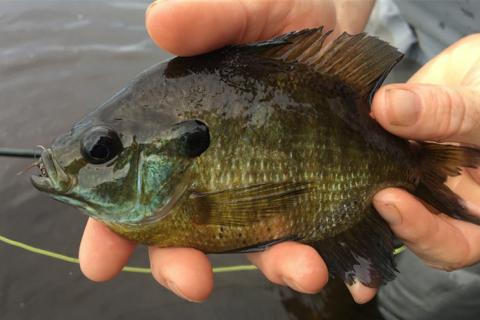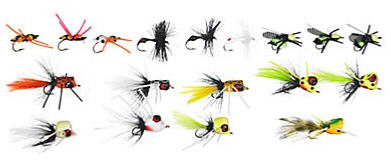
While many fly anglers start their fly-fishing endeavors by honing their skills and practicing their technique targeting panfish such as bluegills, they quickly move on in search of bigger prey. Just because fly-fishing for bluegills can be done easily, it doesn’t mean it can’t be fun or adventurous. Not only are bluegills a blast on a light fly rod, but catching them can be done all summer long in almost any weather and water conditions you might encounter.
Bluegill Seasons for the Fly Rod
Spring: In the early spring and summer, targeting bluegills is as easy as waiting for the water to warm and looking for the tell-tale signs of fish cleaning off the beds. Bluegills move into sheltered ponds, lake coves, and sunny shorelines when water temperature reaches around 65 degrees Fahrenheit. The males create beds in shallow water (1 to 4 ft deep) and the females join soon after to mate and lay eggs. While the gills are on the beds, they will be aggressive towards any fly that happens to find its way into the area of the bed. Be conscious that these fish are there to spawn and catching and keeping too many could hurt the fishery you are having fun fishing.
Summer & Fall: During the summer and fall months, bluegill will form loose schools and cruise weed edges and shoreline structure looking to eat minnow aquatic invertebrates and terrestrials. Summer and fall bluegill can be taken on top water or subsurface patterns. When you hit the water you plan on fishing, watch to see if fish are rising to naturals. If you don’t see rings on the surface start with nymphs or small streamers until you get sign that they are willing to come to the surface to feed.
Fly Patterns to Use
 |
| Popper Fly patterns offer distinctive body styles and enticing action and are ideal for waters where panfish are. |
While Bluegills will eat almost any nymph, dry fly, or streamer, some fly patterns will certainly produce better than others. Gold bead-head nymphs (Brassie, Hares Ear or Pheasant Tail) will really get the attention of fish even in dark water, but the weight will also get flies down to deeper fish. When it comes to streamers, small Woolly Buggers or Mohair Leeches will do the trick. These streamer patterns in black or olive will produce in almost any water, and adding a bead-head or lead free body weight will get flies down deep so you can strip them and entice fish to bite. When it comes to dries, small Foam Ant, Beetle and Hopper patterns work, but many say the best fishing is with small Foam Poppers. These tiny flies create a disturbance on the water surface calling fish to the surface to feed.
Presentation
Keeping in mind that bluegills are plentiful and aggressive, experimenting with different retrieve styles can help you figure out what works for the fish in the specific body of water you are fishing. Keep changing from fast to slow retrieves, strips and pauses until you figure out the combination that works for you. In general terms, slower retrieves seem to work better for both nymphs, and dry or popper patterns. With streamers, short quick strips seem to get the bite more times than not.
Fishing for bluegills is often how many of us first fall in love with fly-fishing. Taking the time to get reacquainted with where and how to target gills with a fly rod can be both fun and rewarding for anglers of all ages and skill levels.
- 9803 views

